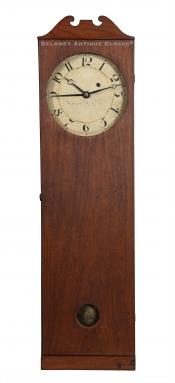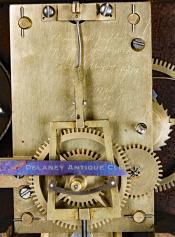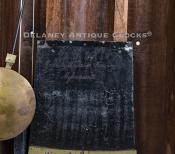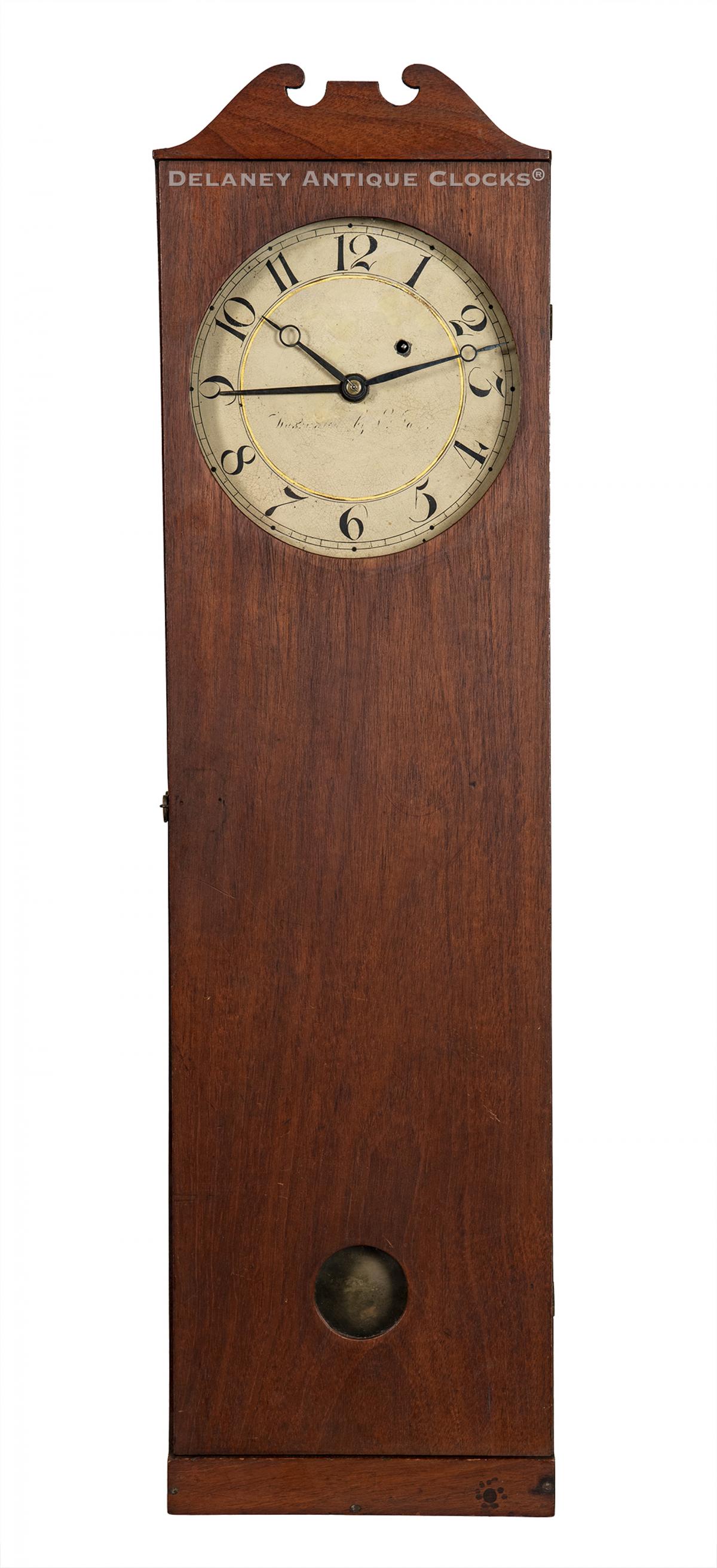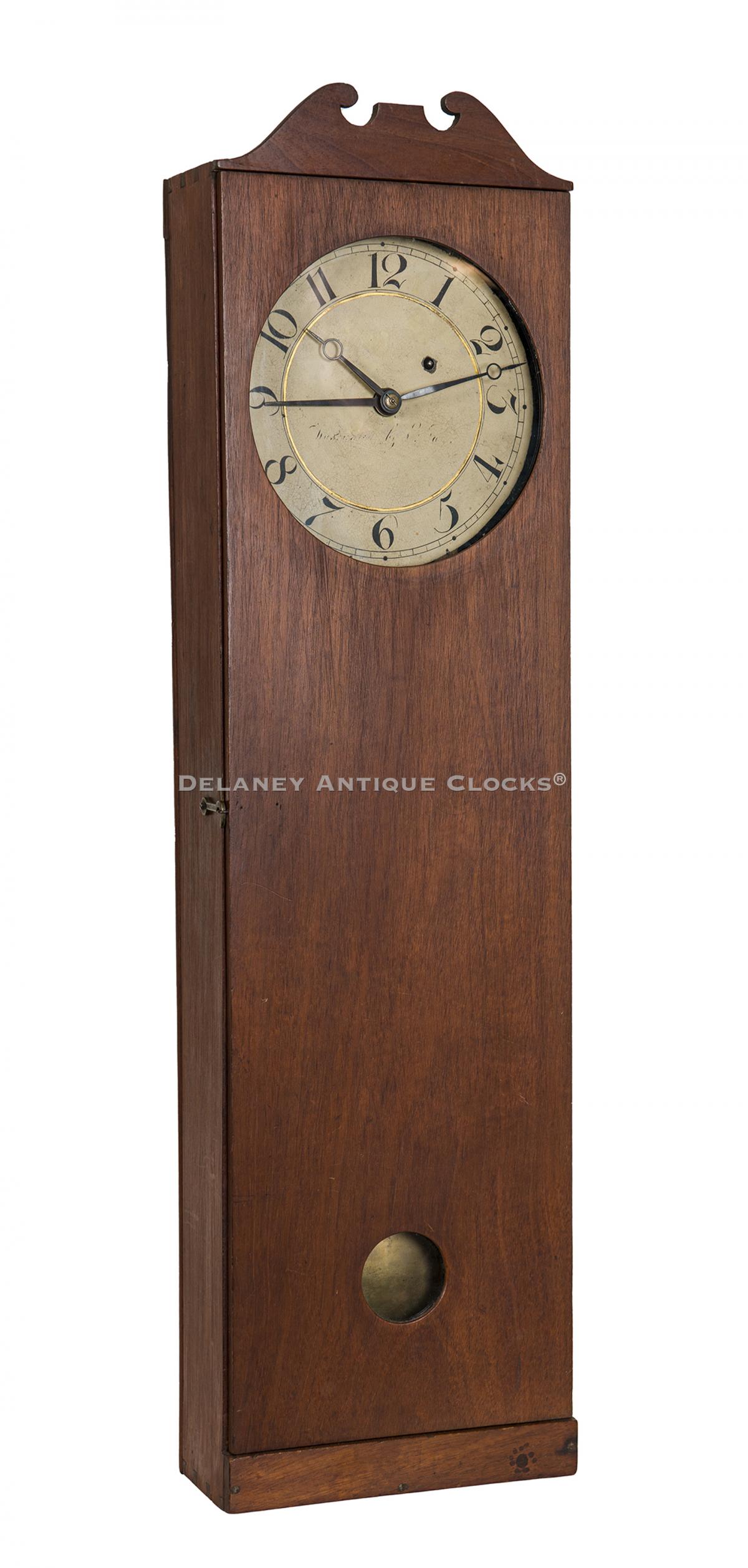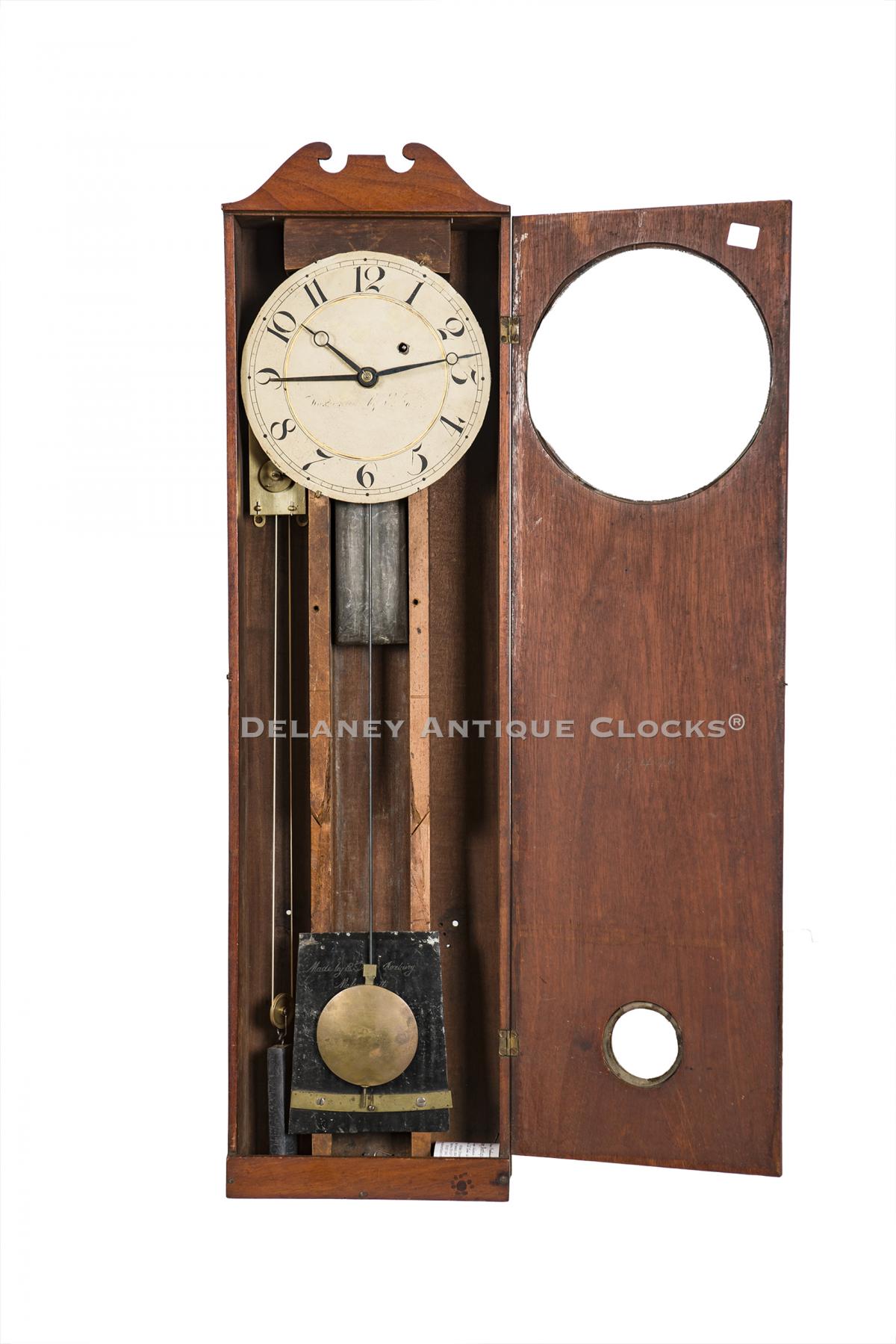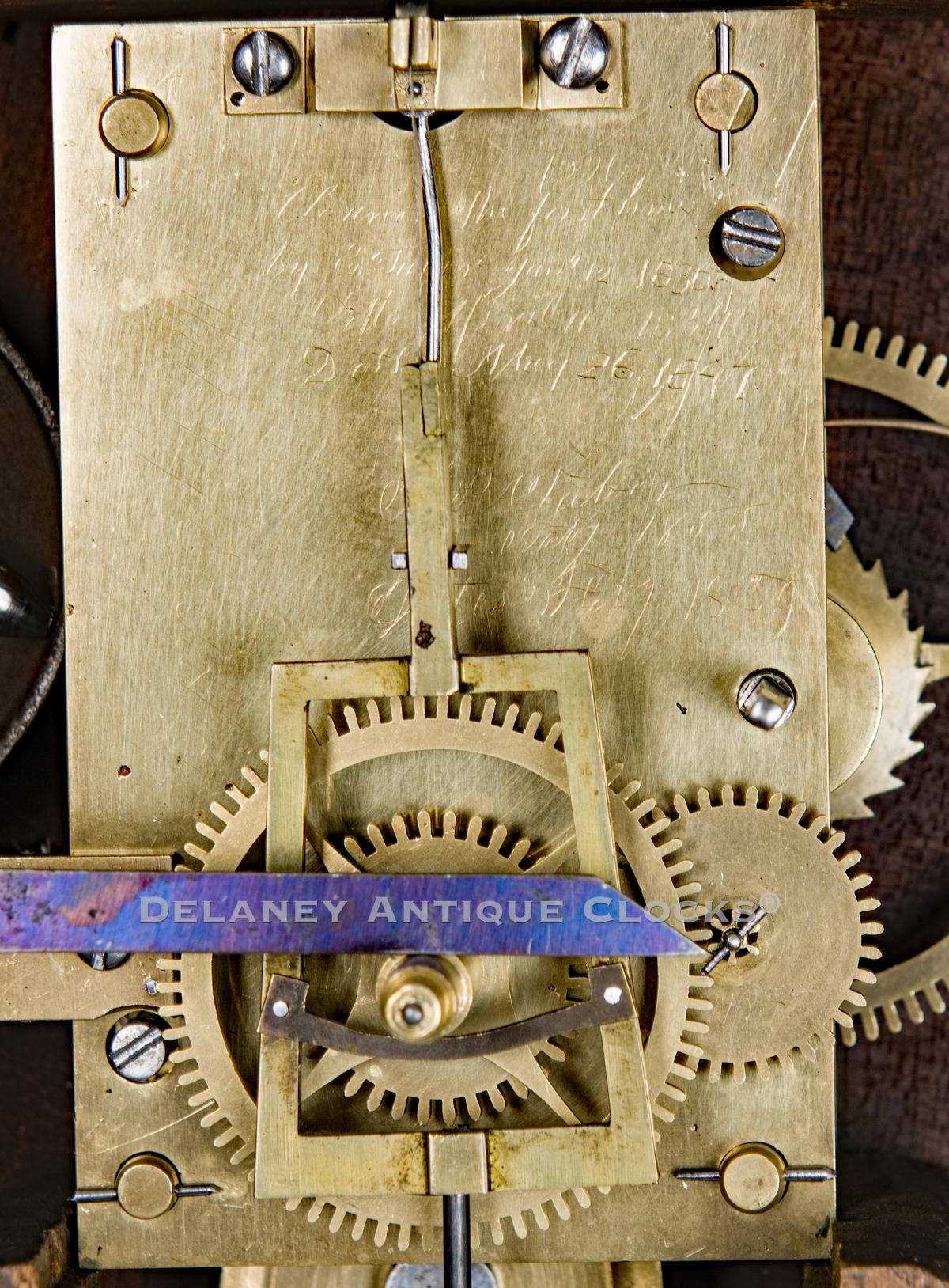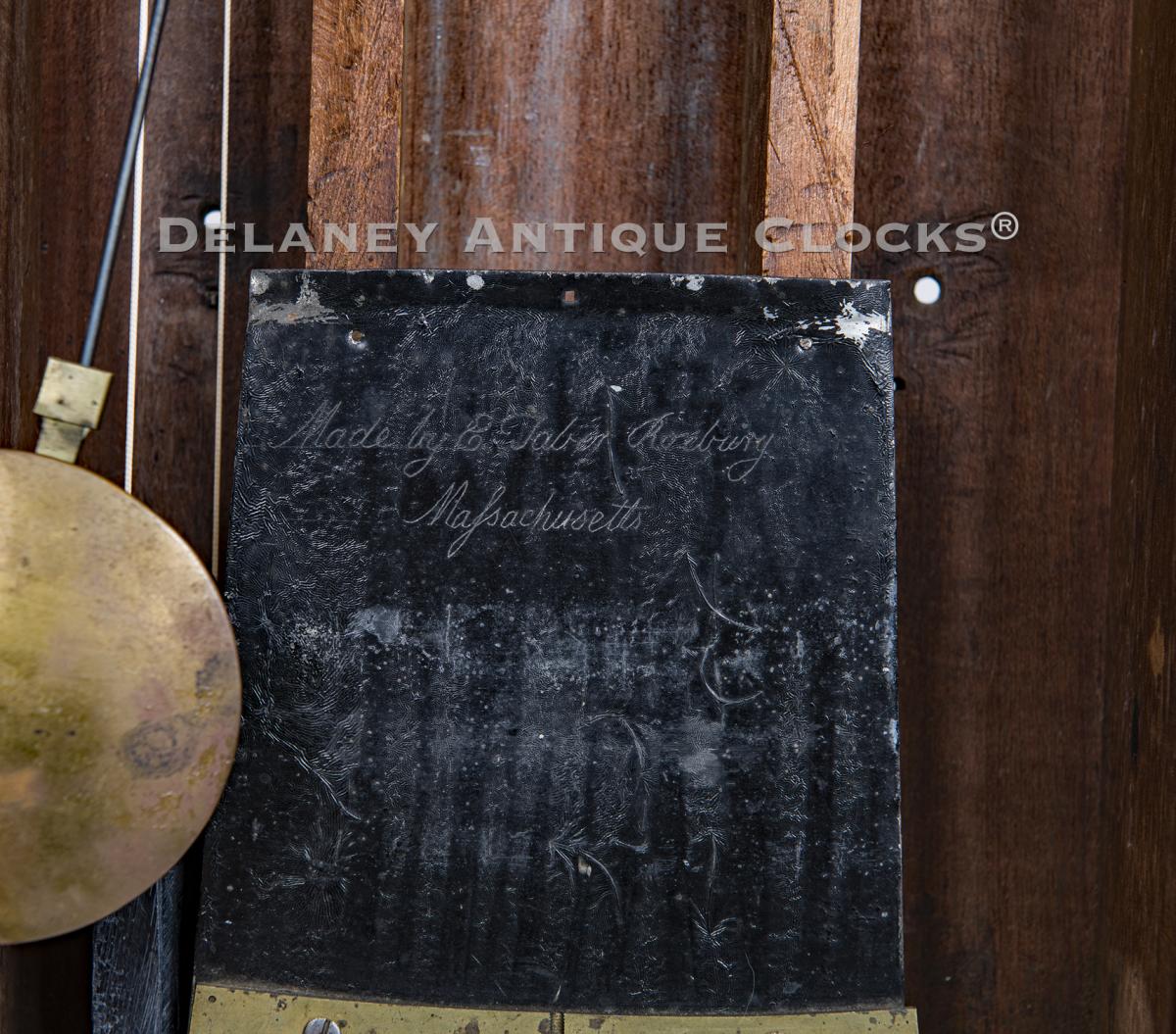A rare Elnathan Taber Mahogany case Coffin Clock made in Roxbury, Massachusetts, on June 16, 1820. 222073.
This rare clock is signed in three locations by the Maker. The first and most obvious location is on the dial. Here, the signature reads, "Warranted by E. Taber." The second signed location is on the weight tin. It reads, "Warranted by E. Taber Roxbury / Massachusetts." The last location is on the front plate of the movement. Here Elnathan engraved, "Made by E. Taber Jun 16, 1820." Having this clock signed in so many locations by its Maker is a rare treat. The addition of the manufacturing date is a seldom-seen inscription.
This is an unusual form. We don't know what these clocks were originally called when sold in the 1820s. Today, the form is known as the "Coffin clock." This simple case design provided function without the fuss of ornamentation or colorful decorations. It is a no-nonsense design. The case design and construction protect the components inside. Perhaps their original use was in a tavern. The alarm suggests that they may have been purchased for a bedchamber. It is fun to speculate.
The case is neatly constructed in mahogany and retains an older surface. The box features dovetail construction at the top and bottom of the main structure. The top of the case is fitted with a cornice molding or a stylized swan's neck pediment. The front of the case opens as a door. One will notice the circular openings for the dial and the pendulum bob. These are for viewing, and both are fitted with protective glass. Unhook the latch on the left side, and the door opens to access the interior of the case.
This iron dial is painted. A closed minute ring frames the large Arabic-style hour numerals. A gilt inner circle defines the other side of the chapter ring. The Clockmaker signs this dial across the center of the dial. The signature reads, "Warranted by E. Taber" in script lettering. The hour and minute hands are wonderfully hand-filed and display the time. The third hand on this dial is used for setting the alarm.
The 8-day time-only movement features brass construction and is weight-driven. The movement is secured to the backboard with two thru-bolts. These are diagonally positioned on the back plate. Incredibly, these have survived. The two brass rectangular-shaped plates frame the gearing. Four brass pillars secure these. The front plate is richly engraved with repairman dates. Elnathan himself signs the first four. The first reads, "Cleaned the first time / E Taber June 12, 1836." Then below this reads, " Ditto May 26, 1847 / Thos Taber / Feb 1855 / Ditto Feby 1859." Thomas Taber was Elnathan's son. The hardened steel arbors are mounted between the plates, supporting the brass gearing. The pendulum hangs from the bridge mounted to the top of the front plate. Overall, the movement is of excellent quality, typical of this Maker. The pendulum is constructed with a steel rod and a brass-faced lead bob. The brass face is, of course, visible through the lower opening of the front door. The motion of this indicates the clock is operating. Please note that the original lead time weight descends a channel in the center of the case directly below the works. This channel is framed in thick white pine stock.
This clock features a separate alarm mechanism that is mounted inside the case. It is weight-driven and requires winding after eight days of use. The alarm movement is wound independently of the time movement. The weight travels in a channel on the left side of the case under the alarm movement. When activated, the alarm uses a hammer to strike a bell above it.
A piece of tin separates the bob from the weight in the lower section of the case. A brass cross piece is used to secure the pendulum for travel. This is fitted with a tie-down to secure the rod in the center. The tin is painted black. In this location, the clock is signed. The signature reads, "Warranted by E. Taber Roxbury / Massachusetts."
This attractive clock measures approximately 35 inches long, 8 and 7/8 wide, and 3.5 inches deep. It was made circa 1820.
This case form is an unusual and interesting variant of Simon Willard's Patent Wall Timepiece. This may be one of the most challenging variations to find. So few have come onto the marketplace in the last 50 years. It is logical to assume that they were made in very limited numbers.
Inventory Number 222073.
Elnathan Taber was born in Dartmouth, Massachusetts, on February 14, 1768, and may have died in Dartmouth, Massachusetts, on February 27, 1854, at the age of 86. His grave was moved from Dartmouth to Forest Hills Cemetery in Jamaica Plain on October 29, 1870. His parents were Thomas and Elizabeth (Swift) Taber. Elnathan is the older brother of Stephen Taber, whose fortune helped found Taber Academy in Marion, MA. Both brothers traveled to Roxbury and were trained as clockmakers by the Willards. Elnathan was just 16. After serving his apprenticeship, Elnathan stayed and worked in Roxbury. His shop was located on Union Street. Union Street was renamed Taber Street in April 1868 in his honor. He was the first resident of that street. William Cummens also moved there and set up shop at the corner of Winslow. This short street was between Warren Street and Winslow Street. Elnathan maintained a close working relationship with his mentor Simon and became one of his most famous apprentices. He was authorized by Simon to make his patent timepieces during the patent period. He was also a prolific repairman. His name can be found engraved on numerous Boston area-made clocks as a service record. Elnathan married Catherine Partridge in January 1797. They had four children between the years of 1797 and 1811. Catherine had three sisters who also married clockmakers. Her sister Elizabeth married Abel Hutchins, and Mary (Polly) married Aaron Willard. A third sister married Samuel Curtis. Over the years, we have owned and sold numerous tall case clocks made by this fine clockmaker. In addition, we have owned a good number of wall timepieces in the form of banjo clocks and coffin clocks, as well as several of the Massachusetts shelf clock forms.

